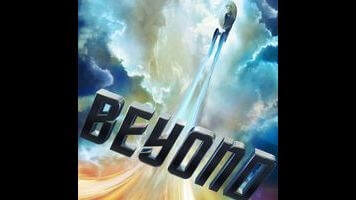Bringing some of the physics-defying action of Lin’s Fast & Furious sequels (and, somehow, a motorcycle chase) into futuristic space, the movie finds the Enterprise flying into a trap laid by Krall (Idris Elba, unrecognizable), whose drone army attacks the starship, breaking it up into pieces. The basic outline of Star Trek Beyond bears a passing resemblance to one of Pegg and Edgar Wright’s paeans to friendship in the face of Armageddon: Bored stiff on their five-year mission, the crew thinks of nothing but the moment they’ll get to finally leave the Enterprise, only to have it snatched away in an instant; separated in pairs, they venture from their escape pods to start over in a long-lost, century-old Starfleet vessel that was ditched on the surface of the unknown planet, saving the day to get back to where they started, but with a newfound sense of purpose.
The drone attack, in which the familiar interior corridors of the Enterprise become twisted and punctured as the camera weaves in and out of holes in its hull, also gives the movie its most memorable image: Kirk, his face reflected in the window of an escape pod, taking one last look at the bridge before rocketing away to watch the Enterprise’s wreckage crash in flames into an alien terrain. From here on out, the crew members have to rely on their supplies of can-do spirit and pithy one-liners and on their limited, intractable personas: Kirk, the one who gets to use his fists; pointy-eared Spock (Zachary Quinto), the one who’s very serious; Uhura (Zoe Saldana), the one who has the patience of a saint; Chekov (the late Anton Yelchin), the one who’s always yelling; Bones (Karl Urban), the one who has all the best jokes; Sulu (John Cho), the one who never gets anything to do, but still seems like a cool guy; Scotty (Pegg), the one who’s Scottish.
The great Star Trek antagonists are negative mirror images of the Enterprise and the group-effort cause of the Federation (the collectivist Borg, the totalitarian Romulans, etc.), and in that regard, Krall has all the making of a perfect villain, though explaining why would constitute a major spoiler. Yet his motivations get only a cursory exploration; though in many ways a corrective to its predecessor, Star Trek Into Darkness, Beyond pushes Star Trek even further away from being a franchise of ideas. With Lin at the helm, and the Enterprise crew reimagined as a family unit in the mold of Dom Toretto’s gang, the movie bounces along, hurtling its heroes over colliding wreckage and into currents of artificial gravity, pausing just long enough for a punchline or a knowing exchange of looks.
For thoughts on, and a place to discuss, plot details we can’t reveal in this review, visit Star Trek Beyond’s Spoiler Space.


 Keep scrolling for more great stories.
Keep scrolling for more great stories.